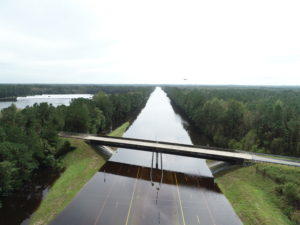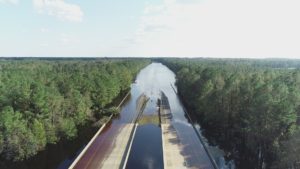
Hurricane Florence was the brutal and long-lived Cape Verde storm that hit the shores of the Carolinas this September. The storm claimed 53 lives and caused more than estimated $17.9 billion in damage to homes, roads and infrastructure.
With highways flooded and almost every element of community infrastructure affected, the North Carolina Department of Transportation (NCDOT) led one of the most successful response drone operations in the United States, mobilizing 15 teams of drone pilots in a coordinated effort to obtain critical aerial data.
Darshan Divakaran, NCDOT’s Division of Aviation UAS Program Engineer, spoke to DRONELIFE about the disaster response mission.

DRONELIFE: It seems like one of the key elements of the mission was your ability to mobilize the resources and plan how best to utilize the drones and pilots. How did you make that happen?
Divakaran: NCDOT started planning a week prior to Hurricane Florence making landfall at the NC coast. We had to prepare for the worst and hence had to mobilize the network of public safety, infrastructure, and UAS experts to support the state’s emergency response. We coordinated our plans with FAA, Emergency Management, FEMA, National Guard and other federal and state agencies to ensure no interference with manned response.
15 teams of drone pilots were part of this mission. How did you mobilize such a large number of teams in a relatively short amount of time?
Our 15 teams consisted of pilots from state agencies like NCDOT, NC State Highway Patrol, NC Public Safety Drone Academy and on call consultants like Dronescape, Precision Hawk, North State Engineering and SM&E. This was the first time both public and private sector worked together for emergency response. The drones used in the operations were from both DJI and senseFly.

Did you have a single command and control? How did you communicate and work with the field based teams?
We had only one command center, at Division of Aviation office. The flight teams were provided with Viper Radios and unlocked WiFi hotspots to upload images and videos. Daily, each morning, we would have a call in with all the teams and update them on airspace restrictions, TFRs and other concerns.
You mentioned that there were no civilian based drones in the airspace. How did you get that message out to the public?
NCDOT created a social media campaign alerting the public about “No Drones in Disaster Zones” – aiming to make drone owners aware they cannot fly in disaster zones, helping keep hobbyists from interfering with helicopter response efforts. We had ZERO incidents of civilian drones interfering with response/recovery operations
How were the drones used to aid in decision making after the first 24 hours after Florence struck?

After the first 24hours, NCDOT deployed half the teams and positioned them in different areas in NC. Along the way they would report traffic conditions, road closures and flooded areas. The rest of the teams were deployed as flight requests came in.
Information was disseminated to the appropriate agencies via online dashboard and to the public via social media.
In an NCDOT release describing the response, Bob Huber, State Local Tribal (SLT) program manager for the Federal Aviation Administration’s Unmanned Aircraft Systems Integration Pilot Program praised the NCDOT team’s drone response.
“I have not seen such a cohesive, selfless, focused and collaborative team operate the way your team does in quite some time,” Huber said.
CEO DroneLife.com, DroneRacingLife.com, and CMO of Jobfordrones.com. Principle at Spalding Barker Strategies. Has enjoyed working with and around the commercial drone industry for the last 10 years. Attendance and speaker at Industry Events such as Commercial UAV, InterGeo, Interdrone and others. Proud father of two. Enjoys karate, Sherlock Holmes, and interesting things. Subscribe to all things drone at DroneLife here. Email is Harry@dronelife.com. Make Sure that you WhiteList us in your email to make sure you get our Newsletter. Editor1@dronelife.com.







[…] Read more: An Insider Look at North Carolina’s Intense Response to Hurricane Florence […]